Central Europe’s most exquisite city is German in name, Italian in appearance, and Bohemian in spirit.
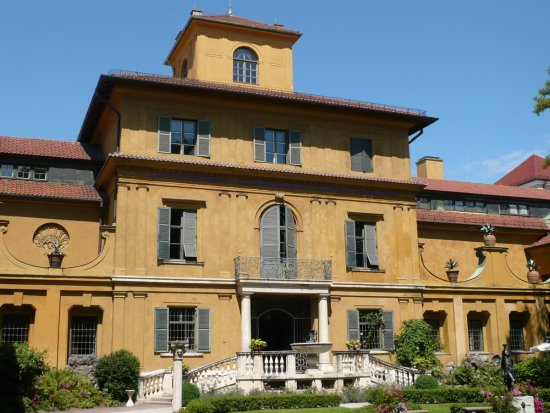
Lenbachhaus, Munich. Photo: Usien. Source: Wikimedia Commons.
I had gone to an opening at the Städtische Galerie im Lenbachhaus — Munich’s most happening public art space, entered through a subway station; don’t miss it — and all of the schickeria were there. (The word comes from chic and refers to the smart set.) People were mostly bronzed and blue-eyed and eerily beautiful, many of them were wearing the sort of clothing that is usually implausible off the runway. Versace things with zippers in strange places, or leather turtlenecks with epaulets. Others were dressed in a kind of casual high fashion. Hermès scarves, discreet earrings, gorgeous shoes. Everyone looked clean and healthy and fresh.
As I passed a vitrine of children’s drawings collected by Paul Klee, I heard a man with a small mustache say emphatically to a radiant woman with long blond hair swept up on top of her head: “But Countess, you are the very essence of the avant-garde.” In Munich, many of the avant-garde are countesses, and many of the countesses are avant-garde. This strange mix is the very essence of the city. According to the polls, nearly everyone in Germany would rather live in Munich than anywhere else, and the city is acutely aware of this fact. But Munich brings great flair to this sense of its own superiority, and since it is, before all else, the most exquisite city in central Europe, one is inclined to forgive the local arrogance.
Munich is chockablock with grand and elegant schickeria who spend weekends in the countryside and live in castles that are reproduced on the national currency. The alternative schickeria are equally aestheticized; there is very little of the type of grunge one associates with the vanguard scene elsewhere in Germany. Munich’s art and theater and film people have a certain winsome self-consciousness, as though they are eternally anticipating the photographer. Even the people who are not schick at all somehow avoid the tubby bourgeois lumpenness so apparent in Frankfurt and Hamburg; here, whatever you do is a style statement. The country’s glossy magazines are all published in Munich, and the fashion industry is based here, and some of the film industry as well. The restaurants are beautiful; the museums are beautiful; even the orchestra (no, really) is beautiful.

Munich skyline. Photo: Mwinog. Source: Wikimedia Commons.
The pleasant village that was abruptly transformed into a major urban center in the first half of the 19th century is hardly evident, and this gives Munich a theatricality that is both magnificent and creepy: much of the time you feel as though you are strolling through an opera set. Munich is full of constructed vistas, grand boulevards, streets that terminate in churches or culs-de-sac or parks; the Neoclassical buildings and the neo-Baroque ones and the neo-Gothic ones and the fascist ones shoulder one another like a family of peacocks. There is a profusion of trompe l’oeil effects and false perspectives.
This sensation of artifice only increases if you know that nearly half the city was destroyed during World War II, and reconstructed — exactly and perfectly — in the late forties and early fifties. Bavarians have the skill and money to build and maintain anything: theirs is the strongest economy in Germany, and the German economy is pretty strong. Taxes are not low in Munich, but citizens are quite happy to see their money spent on sustaining their city as a sort of august public monument to Bavarian splendor.
Munich is Italianate in form and in sensibility. Bavarians go on and on about how Italian they really are and about the five-hour drive to Venice and about the region’s Catholicism, which can be warm and folksy or extravagant and lofty or incredibly kitsch. The people of Munich like extremism, and they don’t really mind what kind of extremism it is. So the architecture is extreme, the chic is extreme, the faith is extreme, and the politics are extreme. This was, of course, the city that Hitler called “the capital of our movement,” but it was also the center for the world’s first Soviet state after the Soviet Socialist Republic of Bavaria was declared in 1918. And it was home to the first society for the prevention of cruelty to animals, in 1841.
On a recent visit, I noticed posters for the Annual Bavarian Tattoo Festival, and, beside these, placards for the Freaky Fuckin Weirdoz, whose concerts were sponsored by the Cultural Department of Munich. This seems rather liberal.
In 1987, the Bavarian government passed an ordinance requiring that blood tests be performed on anyone suspected of carrying HIV and that anyone with the AIDS virus who does not follow a code of “proper behavior” may be arrested and detained indefinitely. This seems rather illiberal.
The HIV legislation is only one hint at the Bavarians’ impenetrably complex attitude toward the physical: The relationships between vanity, guilt, exhibitionism, repression, and longing are as convoluted here as anywhere on earth. Though the local tendency is toward discretion and understatement, there is legal prostitution in Munich (HIV questions notwithstanding).
This is a super-body culture, and you haven’t really done Munich properly until you’ve spent a certain amount of time publicly naked. The Isar flows through Munich much as the Seine through Paris or the Arno through Florence. If you’re feeling all Bavarian and positive about yourself, you can walk down by the river where it runs along Haidhausen and the Altstadt, between the locks, and, in any season but chill winter, take off all your clothes and plunge naked into the water. Total strangers frolic about, splashing each other, sometimes lying out on the little sandbars in the river. Passing pedestrians and motorists pay little attention.
An area of the Englischer Garten, Munich’s great park, is reserved for naked sunbathing. I was lately drawn into conversation there with a woman who had stopped to ask me the time. She was a model, she explained, and needed the overall tan that only nude sunbathing could provide. “I’d take off that watch if I were you,” she advised me as she left. “It can leave a line just as unpleasant as the one left by clothes.” The daytime atmosphere can be flirtatious, but it need not be. There are plenty of middle-aged and elderly people who go to lie naked in the meadow and soak in the sunshine and read a book. The voyeurism factor is low. But if you return to the Englisher Garten at night (a bit outré, but not unusual), you will find everyone naked again.
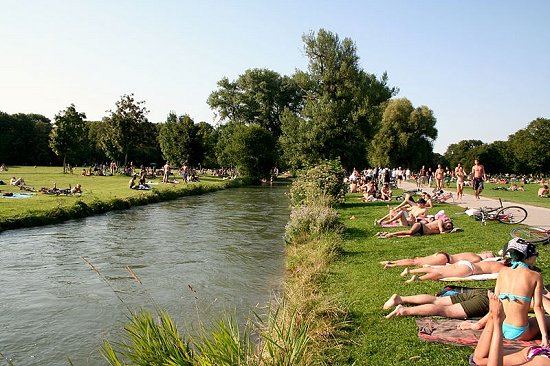
Schwabinger Bach im Südteil des Englischen Gartens. Photo: David Kostner. Source: Wikimedia Commons.
The Altstadt, or Old City, is the most fantastic part of Munich, with its magnificent proportions and fabulous elegance. No one from outside the strong German economy can really afford to buy the incredibly expensive things in the incredibly exclusive shops, but it’s fun simply to look, and to eat in the cafés. Though some establishments are smarter than others, basically everything in this area is top-notch. The bar to go to is Schumann’s, right on Maximilianstrasse, where you will find local celebrities, the very moneyed, and insolent waiters.
Historically, the area called Schwabing was inhabited by bohemians. It is now too expensive for most of them, so it has by and large become middle-class. There is still a busy street scene on Leopoldstrasse, Schwabing’s main thoroughfare, and some of the restaurants there — the slightly grungy Adria, for example, and the Venezia Eiscafé — continue to have a redoubtable following. So too do Drugstore (nostalgically sixties) and Café Extrablatt (not what it once was, but a bit of a classic).
The lower part of Schwabing, near the university, offers better fun. Amalienstrasse is dominated at one end by the bulk of the Akademie der Bildenden Künste, where both Kandinsky and De Chirico exhibited their work. The street is crammed with antiquarian bookshops and cafés. The ultramodern Lunis Café is the nicest place to dine, with its attractive graden out back; farther down the block at News Bar — part of the international chain — you can take a magazine of paper to read while you eat. Art students clutching the print media in their hands gesticulate to each other rather passionately in both these places. Türkenstrasse, similar in feeling and running parallel to Amalienstrasse, has, among other things, a wonderful bar: Alter Simpl, which is open late and attracts a slightly more sophisticated crowd than the Amalienstrasse places.
East of Schwabling, in Bogenhausen, visit Six Friedrich, the oldest gallery for contemporary art in Munich. Six Friedrich herself is a piece of magnificent theater, witty, vivid, a bit louche; the lower floors of her spectacular house are her exhibition space, while she lives and entertains grandly on the upper floors.

Akademie der Bildenden Künste, München. Photo: Maximilian Dörrbecker. Source: Wikimedia Commons.
The artists and actors and political radicals who in another era congregated in Schwabing have now removed to Haidhausen, south of the Isar. The Gasteig, near the river, is Munich’s answer to the Pompidou: a cultural center housing the Philharmonic, the conservatory, the city library, the adult education center, several smaller theaters and concert halls, and various rooms used for symposia, conferences, and performances. It is, uncharacteristically for Munich, a very ugly building, but it sits well in its surroundings. Opposite is the amazing Art Nouveau Müllersches Volksbad, a public bath with the best indoor swimming in Germany.
But the real Haidhausen lies deeper in, near Weissenburger Platz. The district is striking for its mix of artists and newcomers; in most of Munich everyone is achingly purebred Bavarian, but Haidhausen has many Turkish, Gypsy, and eastern European immigrants. Shops sell a broader variety of foods, and the kitschy, the avant-garde, and the profound are mixed together haphazardly in the windows. On Wörthstrasse, you can find cafés, a theater, a music club, and a workers’ bar all on the same short block.
Many of Munich’s most interesting public exhibitions of vanguard art take place at the Küstlerwerkstatt, on Lothringerstrasse in Haidhausen. The nearby Ladengalerie often has complementary exhibitions. Café Grössenwahn, next door on Lothringerstrasse, was decorated by the artist Flatz; the striking furniture, thousands of tiny lights, and strange textured walls give the place a pleasantly voguish atmosphere. This is a center of the cutting-edge art scene, and late at night you’ll find all the notables gathered here, as well as many serious younger artists. The drinking can be heavy, but the food is good and the atmosphere is always charged; people tend to burst into song as the night wears on.
Gärtnerplatzviertel, while smaller and less vivid than Haidhausen, is known for an unusually high concentration of galleries and a large gay population. The Dany Keller Galerie has the best reputation. Gärtnerplatz itself is an elegant round piazza; the Interview Café in the center makes for excellent people-watching. The surrounding streets have sumptuous fabric shops, temporary art exhibits, shoe stores, and an inexplicable plethora of hyper-stylish opticians.
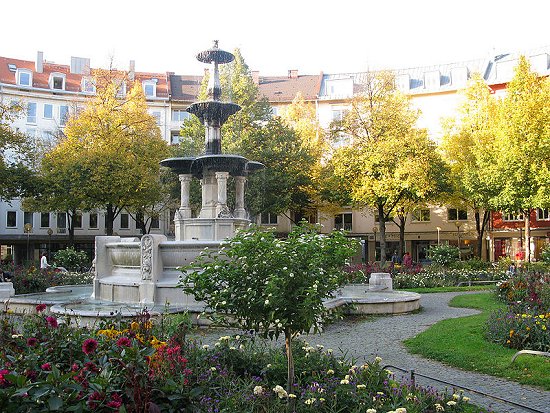
Weißenburger Platz, Haidhausen, Munich. Photo: Schlaier. Source: Wikimedia Commons.
Munich is very much a city of trends. The fact that someplace looks good is not enough for the locals; it has to have been taken up by some set and to have become the darling location of the moment. But Munich, snobbish as it can be, is also polite to visitors, and strangers are usually treated with reasonable courtesy even at the hottest spots.
At the moment the schickeria prefer the James Café. James, who comes from Kenya, has the looks of a 1920’s American jazz musician and a shy but very gracious manner. He seems unsure why everyone is at his little place, though he knows all the crowd by name. His tiny café has only 11 tables and a small bar. The room is pleasant, the location smart but not obvious; fashion editors and museum directors come here to eat light dinners (light by Munich standards) and drink Prosecco, the eternal drink of the Munich aristocracy.
How Bavarians manage to keep their figures is unclear. There is nothing slenderizing in their diet. If you watch fashion models in the restaurants, you notice that they are having less meat and potatoes, but they are definitely not subsisting on salads.
Munich is also a drinking town. Beer gardens are probably the most famous Bavarian tradition. In early 1995, neighbors tried to restrict the hours of a noisy Biergarten; this led to protests from the regulars, which escalated into a general uprising against attempts to constrain the local custom. The “Beer Garden Revolt” swept through Munich, with the result that the Biergärten now have a kind of sacrosanct protection. They’re very pleasant and laid-back places, where people cross class boundaries to site side by side at long tables, and they are a welcome escape if you find all the smart haunts wearing thin. Biergärten are a bit too populist, though, for most of the crowd found at the James Café.
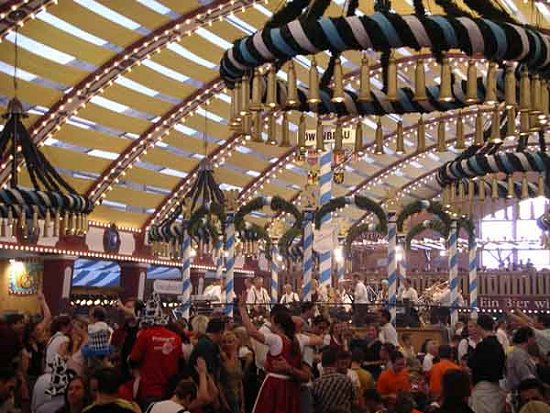
Inside a tent at Munich’s Oktoberfest. Photo: Michael Chlistalla. Source: Wikimedia Commons.
By 11pm or midnight, the schickeria are likely to be at the Nachcafé, up a long flight of stairs on Maximiliansplatz. This Munich fixture has a floor that is illuminated in sections, with a glowing, deep blue path at its center. You should inquire who’s performing before you go; on a good night you can hear some of the world’s best jazz, but you might also find yourself listening to a female trio with a drum machine playing seventies disco songs. It’s possible to eat and drink here until 5am, but for most of the schickeria Nachtcafé is a place to visit after dinner and before hitting the clubs in the small hours. They’ll have coffee and drinks, regroup forces, and muster energy.
Really late, everyone is at P-1. The place has been open for 15 years, and it’s still the only club for the schickeria. Located in the back of the Haus der Kunst, which was originally built by Hitler to store his collection of decadent art, P-1 has those clean, dramatic lines that defined fascism as a style statement, at least in the eyes of some Bavarians. The music is always good. The Candy Bar sells lots of chocolates and sweets; a sandwich bar prepares a terrific roast beef and mozzarella baguette. Naturally, there’s also plenty to drink. Many of the people here are named Metternich or Habsburg or Hohenzollern or Maltzahn, and most have VIP cards that let them in ahead of the long queue. There are also, however, lots of club kids and models and the occasional film or TV personality. You can go earlier, but the place is best after 2am. Dancing here recently, I noticed a particularly beautiful group in the corner — men with rippling muscles and girls with shaggy blond manes. They were all wearing orange overalls and dancing hard enough to break through the floor.
“Any idea who those people are?” I nonchalantly asked someone.
“Oh, there are always a few of the proletariat here,” she said. I must have looked startled. “It’s good to have them. It makes the club alive. I always think the proletariat is quite attractive in its way, don’t you?”
Near dawn, as I was about to leave, a thin high-strung woman in a burgundy silk dress fainted near the door. A boy with big white teeth and a dragon tattoo helped his girlfriend step over her to the exit.
“Bloody countesses and princesses,” he muttered. “Still, I guess it wouldn’t be much of a place without them.”
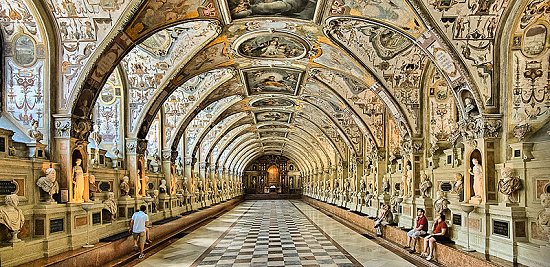
Das Antiquarium at Residenz, the former royal palace of the Bavarian monarchs of the House of Wittelsbach. Photo: Raphael Fetzer. Source: Wikimedia Commons.











